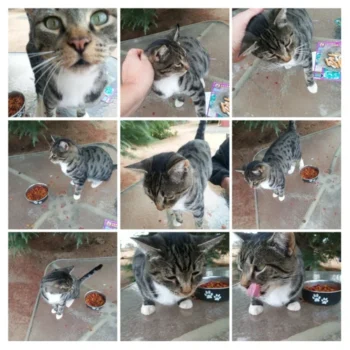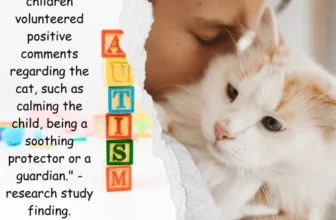As cat owners, we all love to learn about the unique behavior of our furry friends. And when it comes to California Spangled cats, the fascination only grows. These elegant creatures with their distinctive appearance and playful personality are a delight to have around. However, raising children with cats requires understanding their behavior and temperament. In this article, we will explore in-depth the behavior and traits of California Spangled cats, and provide step-by-step guidance on how to teach your children to interact with them in a safe and responsible manner. So sit back and get ready to embark on an exciting journey of discovering all about the beautiful California Spangled cats.
Understanding Your California Spangled Cat

Understanding the unique behavior of California Spangled Cats
California Spangled Cats may seem like your typical domestic feline, but this breed has some distinctive attributes that set them apart from the rest. Whether you are a first-time pet owner or have experience with cats, it is crucial to understand the temperament, personality, and communication methods of this breed. Teaching your children about California Spangled Cats can also be an exciting opportunity to cultivate their love for animals while instilling responsibility and respect. In this article, we will take a closer look at the origins, appearance, temperament, and behavior of California Spangled Cats to help you better understand and appreciate these unique felines.
Origins and Appearance
The California Spangled cat is a unique breed that was first created in the 1980s by a Californian woman named Paul Casey. This breed was developed to resemble the wild cats of the American Southwest. These cats have a distinctive wild appearance, typically weighing between eight and 12 pounds and measuring up to 20 inches in length. Their coats are covered in spots, which can be anything from spots that are round or oval shaped to ones that resemble the patterns found on a leopard or cheetah.
California Spangled cats appear muscular and powerful due to their large shoulders and hindquarters, and their eyes are almond-shaped and come in a variety of colors such as green, gold, and blue. These cats are popular for their active and playful demeanor, and their intelligence is a trait that makes them easy to train.
The California Spangled cat is a relatively rare breed, which means that they can often be costly. However, it is important to note that California Spangled cats are a purebred breed, with a consistent standard of appearance and temperament. They are also known for their longevity, with a typical lifespan of up to 14 years.
This breed’s unique wild appearance and playful temperament make them an ideal pet for families with children. It is essential for parents to educate and teach their children how to properly care for and train these cats. Teaching children to be responsible pet owners is crucial, and it is recommended that parents introduce their children to the California Spangled cats from a young age.
Temperament and Personality
The temperament and personality of the California Spangled Cat is unique and fascinating. Known for their playful and energetic behavior, they are also incredibly loyal and affectionate towards their owners. Due to their high intelligence and curiosity, they can sometimes be mischievous, but this only adds to their charm and personality.
California Spangled Cats are also known for their independent nature. They like to explore and play on their own, but will still show affection towards their owners when they feel like it. It’s important to understand and respect their need for alone time, but also make sure they receive enough attention and affection from their owners.
In terms of adaptability, the California Spangled Cat is a good fit for families with children. They are patient and tolerant of kids’ playful behaviors, but it’s important to teach kids not to be too rough or invasive with the cat. The cat’s tolerance doesn’t mean that they deserve less respect and kindness.
One thing to keep in mind is that California Spangled Cats can be sensitive to changes in their environment or routine. If there’s a sudden change in their daily routine, they may become anxious or stressed. It’s important to create a consistent and stable environment for your cat, and introduce change gradually and patiently.
Born hunters, these cats have a natural instinct to climb and jump and love to play games with their owners. They are also adept at problem-solving, so puzzles and treat-dispensing toys can help keep them mentally stimulated. However, like all felines, they can get bored and may become destructive if they lack stimulation and playtime.
To keep them happy and healthy, it’s important to allocate enough time for play and exercise. This could mean setting aside time each day to play with them, creating an obstacle course, or providing them with toys that allow them to engage in natural behaviors.
California Spangled Cats have a unique temperament and personality that is both entertaining and endearing. As with any pet, it’s important to understand their needs and personality traits to create a healthy and happy home environment. By providing them with attention, love, and plenty of playtime, your California Spangled Cat will quickly become a beloved member of your family.
Internal Link: Teaching Your Children Kindness Towards Animals and Your California Spangled Cat
Communication Methods
When it comes to communication methods, California Spangled Cats have a unique and complex language. These cats communicate through various vocalizations, body language, and even scent marking.
Vocalizations: California Spangled Cats have a wide range of vocalizations, including meows, purrs, growls, and hisses. They may meow to get attention or ask for food, and they purr when they’re happy and content. Growls and hisses are usually warning signs of aggression or discomfort.
Body Language: These cats also communicate through body language. They may arch their backs when they’re scared or threatened, and they may twitch their tails when they’re irritated. Ear position also plays a significant role in cat communication. If their ears are flattened against their head, it may indicate fear or aggression. However, if their ears are relaxed, it often means they’re happy and content.
Scent Marking: Cats have scent glands located on their faces, paws, and tails, which they use for marking. California Spangled Cats may rub their faces on people or objects they’re familiar with to mark their territory. Additionally, they may scratch furniture or carpet to release their scent.
It’s crucial to understand these communication methods to ensure you’re meeting your cat’s needs and respecting their boundaries. Pay attention to their vocalizations and body language to determine how they’re feeling and respond accordingly.
Link: If you’re introducing your California Spangled Cat to children, it’s essential to teach them about cat communication and boundaries. Check out these California Spangled Cat Introduction Child Safety Tips for more information.
Teaching Your Children About California Spangled Cats

As a parent, it’s important to teach your children to respect and care for animals. One of the best ways to do this is by introducing them to the unique and fascinating California Spangled cat. These cats have a rich history and personality that make them unlike any other breed. By teaching your children about California Spangled cats, you can foster a deeper understanding and appreciation for the creatures with which we share our world. Let’s explore some tips for teaching your children all about these amazing felines and how to properly care for them. For more information on raising California Spangled cats, check out our guide on how to raise California Spangled cats with your kids.
Respect and Responsibility
When teaching your children about California Spangled cats, it is important to emphasize the concepts of respect and responsibility. As a parent, you must ensure that your children understand that they are not toys and should never be treated as such. These cats, like all living creatures, deserve to be treated with kindness, love, and care.
Here are some key points to emphasize when teaching your children about respecting their California Spangled cat:
- Teach your children to approach the cat gently and without sudden movements.
- Teach your children to never pull on the cat’s tail, ears, or whiskers.
- Teach your children to not grab the cat or hold them too tightly.
- Teach your children to avoid disturbing the cat while it is sleeping or eating.
In addition to respecting their cat, children should also learn to take responsibility for its well-being. Whether it’s feeding, cleaning, or playing with the cat, it’s important that your child understands they have a role in caring for their pet.
Here are some ways to teach your children about taking responsibility for their California Spangled cat:
- Set up a regular feeding schedule and have children help feed the cat.
- Show your children how to clean the litter box and encourage them to do it themselves.
- Teach your children to recognize signs that their cat may be feeling sick or anxious, and to notify you or a veterinarian if needed.
- Encourage your children to play with their cat and help keep it active and engaged.
By teaching respect and responsibility to your children, you can help foster a healthy and happy relationship between your children and their California Spangled cat. For more information about raising California Spangled cats with kids, visit /raise-california-spangled-kids/.
Teaching Care and Grooming
Proper care and grooming are essential to maintaining your California Spangled Cat’s overall health and appearance. Teaching your children about these important responsibilities can help them form a strong bond with their feline companion while also instilling a sense of respect and responsibility.
Here are some steps you can take to teach your children about caring for their California Spangled Cat:
- Brushing: Show your children how to properly brush their cat’s fur to prevent matting and tangling. Use a soft-bristle brush and work gently from head to tail, making sure to avoid sensitive areas like the belly and ears. Encourage your child to make brushing a regular part of their daily routine to help strengthen the bond between the cat and child.
- Bathing: While California Spangled Cats don’t need frequent baths, it’s important to teach your child how to bathe their cat when necessary. Use a gentle shampoo and lukewarm water, making sure to avoid getting water in the cat’s eyes and ears. Teach your child to dry the cat thoroughly with a soft towel to prevent them from becoming chilled.
- Nail Trimming: Show your child how to trim their cat’s nails to prevent them from becoming too long and causing discomfort or damage to furniture or other surfaces in the home. Use a pet nail clipper and ensure that you don’t cut into the quick, which can cause pain and bleeding.
- Dental Care: Dental health is just as important for cats as it is for humans. Teach your child to brush their cat’s teeth regularly with a soft-bristled brush and cat-specific toothpaste. Additionally, encourage your child to provide their cat with plenty of dental toys and treats specifically designed to promote healthy teeth and gums.
By teaching your children how to properly care for and groom their California Spangled Cat, you are not only helping them to form a strong bond with their pet, but also instilling important life skills and values such as respect and responsibility. As a result, your child will not only develop a love for animals but also become more empathetic and caring towards other living beings.
You can check out our article on fun activities for children and cats, which provides creative ideas for incorporating playtime and hands-on learning into your child’s interaction with their feline companion to ensure a happy and healthy life for both.
Playing with Your California Spangled Cat
Playing with your California Spangled Cat is a great way to bond with your pet and encourage their physical and emotional development. These cats are very playful by nature, so they’ll love spending time with you and your children. Here are some important things to keep in mind when playing with your California Spangled Cat:
- Choose Safe Toys: Make sure the toys you play with are safe for your cat. Avoid toys with small pieces that can be swallowed or sharp edges that can cause injury. Good options include wand toys, balls, and soft plushies.
- Give Your Cat Space: While it’s tempting to get up close and personal with your cat when playing, it’s important to give them enough space to move around. Give them plenty of room to run, jump, and explore.
- Use Positive Reinforcement: Reward your cat with treats or praise when they do something good during playtime, like chasing a toy or using a scratching post. This will help reinforce their good behavior and encourage them to repeat it in the future.
- Rotate Toys: Cats can quickly become bored with the same toys over and over again. Be sure to rotate your cat’s toys regularly and provide them with new ones to keep them engaged and stimulated.
- Watch for Signs of Overstimulation: While all cats love to play, they can become overstimulated and may need a break. Watch for signs that your cat is getting agitated, like swishing their tail or flattening their ears. If you notice these signs, take a break and give your cat some space.
Remember that playing with your California Spangled Cat is not only fun, but also helps with their physical and emotional development. Be sure to choose safe toys, give them plenty of space, use positive reinforcement, rotate toys, and watch for signs of overstimulation. By following these tips, you and your cat can have many happy playtimes together. And make sure you read our article about California Spangled Cats and Kids Safety to ensure that your children play with the cat safely.
Encouraging Healthy Behavior
As a responsible cat owner, it’s important to encourage healthy and positive behavior in your California Spangled Cat. This includes providing a safe and stimulating environment, nutritious food, plenty of water, and regular vet check-ups. Here are some additional tips to help you encourage healthy behavior in your feline friend:
- Regular Exercise: Encouraging your California Spangled Cat to engage in regular physical activity not only helps keep them healthy, but it can also prevent behavioral issues such as aggression or destructive behavior. Try playing with your cat using interactive toys or providing them with scratching posts to keep them entertained.
- Providing Mental Stimulation: California Spangled Cats are intelligent and curious animals that need mental stimulation as well as physical exercise. Provide toys that challenge them mentally, such as puzzle feeders or interactive games. You can also try hiding treats around the house for them to find.
- Positive Reinforcement: Encourage good behavior in your cat by using positive reinforcement. Reward your cat with treats or praise when they exhibit good behavior such as using the litter box or scratching their scratching post. This will encourage them to continue this behavior in the future.
- Proper Grooming: Maintaining good grooming habits can help keep your California Spangled Cat healthy and happy. Regular brushing can help prevent hairballs and other issues, while bathing and grooming can help prevent fleas and other pests. Make sure to use the proper grooming tools for your cat’s unique coat type to avoid any discomfort or irritation.
- Emotional Development: Pay attention to your California Spangled Cat’s emotional needs and provide a safe and nurturing environment for them to thrive. Spend quality time with your cat every day to help strengthen the bond between you. Check out our article on emotional development for California Spangled Cats for more information.
By following these tips, you can help your California Spangled Cat lead a healthy, happy, and fulfilling life. Don’t forget to provide plenty of love and attention, and enjoy the special bond between you and your feline friend.
Additional Considerations
Now that you have a good grasp of your California Spangled Cat’s behavior and have taught your children about the fundamentals, it’s important to consider a few additional factors. These can be crucial for maintaining a happy and healthy relationship between your children and cat. Keep in mind that owning a pet is a considerable responsibility and requires extra care. In this section, we’ll delve into some essential considerations that every pet owner should keep in mind to ensure the best possible experience for both children and the cat.
Introducing Your Cat to Children
When introducing your California Spangled cat to children, it’s essential to keep in mind that cats can be unpredictable. Here are some steps to follow to ensure a smooth and safe introduction:
1. Prepare your cat
Before introducing your cat to children, make sure they’re comfortable with being handled and being around people. This can be done by gradually exposing them to new situations and people over several days or weeks.
Additionally, make sure your cat has a safe and private space to retreat to if they feel overwhelmed or scared.
2. Supervision is key
When introducing your cat to children, always supervise the interaction to ensure your cat and the children are both safe. Children should never be left unsupervised with a cat, no matter how well-behaved the cat is.
3. Encourage gentleness
Teach children to be gentle and calm around cats. Encourage them to pet the cat gently and avoid pulling their tail or ears. Cats are more likely to enjoy the company of children who treat them kindly and with respect.
4. Watch for signs of stress
Cats can become stressed and anxious in unfamiliar situations. Watch for signs of stress in your cat, such as hiding, dilated pupils, or hissing. If you notice any of these signs, encourage the children to give the cat space and time to calm down.
5. Teach children to respect boundaries
Teach children to respect your cat’s boundaries. If the cat seems uncomfortable or wants to be left alone, encourage the children to back off and let the cat have their space.
Introducing your California Spangled cat to children requires patience, supervision, and respect for both the cat and the children. By following these steps, you can ensure a safe and positive experience for everyone involved.
Teaching Boundaries and Safety
Teaching boundaries and safety is an important aspect of having a California Spangled Cat, especially when children are involved. These cats are known for their playful and adventurous nature, and they might not understand the limits they need to set for themselves. It is important to teach children how to interact with their feline friends in a safe and responsible way.
One way to teach children about boundaries and safety is to establish designated areas for the cat such as a cat bed or a scratching post. This will help the cat understand where they are allowed to play, and it will keep them from getting into mischief. Additionally, it is important to teach children about the dangers of certain household items, such as toxic plants or poisonous foods.
Another way to teach boundaries and safety is to set rules for handling the cat. It’s important to teach children to pet the cat gently and not pull their tail or ears. If a child is too young to understand this, it might be helpful to demonstrate safe handling techniques and supervise interactions.
It’s important to teach children to read the cat’s body language. If the cat is hissing or growling, it’s a sign that they might be feeling threatened or uncomfortable. In such cases, children should be taught to give the cat space and not approach them.
Finally, it’s important to teach children about the risks of playing with a cat roughly. While the California Spangled Cat can be an active and playful pet, it’s important to remember that they are still animals with natural instincts. Children should be taught not to provoke their cat, and to avoid playing with them aggressively.
For a quick summary, take a look at the table below:
| Teaching Boundaries and Safety |
| Establish designated areas for the cat |
| Teach children about household dangers |
| Set rules for handling the cat |
| Teach children to read the cat’s body language |
| Avoid playing with the cat aggressively |
By following these tips for teaching boundaries and safety, children can learn to have a safe and happy relationship with their California Spangled Cat.
Recognizing Medical Needs
It is important for parents to recognize the medical needs of their California Spangled cats in order to keep them healthy and happy. Here are some tips for recognizing common medical issues in cats and how to address them:
| Medical Issue | Symptoms | Treatment |
|---|---|---|
| Gastrointestinal Problems | Vomiting, diarrhea, constipation, loss of appetite | Provide easy-to-digest food, keep them hydrated, and, in severe cases, take them to a veterinarian |
| Urinary Tract Infection (UTI) | Frequent and painful urination, blood in urine, excessive licking of genitals | Take them to a veterinarian for antibiotics and to prevent further complications |
| Dental Issues | Bad breath, tooth decay, difficulty eating | Brush their teeth regularly, provide dental chews or toys, and take them to the veterinarian for regular dental check-ups |
| Allergic Reactions | Scratching, redness or swelling of the skin, sneezing or coughing | Eliminate the allergen in their environment if possible and consult with a veterinarian for medication or allergy testing |
Preventive care is key in keeping your California Spangled cat healthy and avoiding these medical issues. Regular visits to the veterinarian, a balanced diet, and plenty of water can go a long way in keeping them in good health. Additionally, keeping their living environment clean and free of toxins can prevent many health issues.
Exploring Fun Activities for Children and Cats
It’s important to engage your children and your California Spangled cat in fun activities to strengthen their bond and ensure they both get enough exercise and mental stimulation. Here are some unique ideas for activities that both your children and cat can enjoy:
| Activity | Description |
|---|---|
| Treat Hunt | Hide small cat treats or toys around the house for your children to search for alongside your cat. This game encourages your cat’s natural scavenging instincts and helps your children better understand their cat’s behavior. |
| Laser Pointer Chase | Use a laser pointer to direct your cat’s attention while your children move it around. This thrilling game is a fun way to get your cat moving and your children giggling. |
| Cardboard Box Forts | Give your children and cat a cardboard box to play in. Encourage them to use their imagination to create a fort or hideout. Cats love confined spaces, and your children will love hiding and playing with their feline friend. |
| Interactive Toys | Invest in interactive toys for your cat that require your child’s participation, such as a wand toy or a puzzle feeder. This engages your cat’s hunting instincts while also having a shared experience with your child. |
| Teach Tricks | Show your children how to teach your cat basic tricks such as sit, high five, or roll over. This shared activity helps your children bond with their cat while also teaching them the value of patience and positive reinforcement. |
Keep in mind that every cat has their own personality, so not all activities will be enjoyed by every cat. Pay attention to your cat’s body language and behavior to determine what they find enjoyable. With the right activities and a little bit of creativity, your children and California Spangled cat will have a special bond that will last a lifetime.
Conclusion
In conclusion, introducing your children to the unique behavior and characteristics of California Spangled cats can be a valuable and rewarding experience for both parents and kids alike. By understanding the origins, appearance, personality, and communication methods of these amazing felines, children can develop a deep appreciation and respect for the creatures that share our world.
Teaching children about the importance of respect and responsibility in caring for pets is crucial when integrating a California Spangled cat into your family. This includes teaching them the basics of care and grooming, as well as encouraging healthy behavior and playtime.
When introducing your cat to children, it’s important to set clear boundaries and educate them on safety protocols. Recognizing any medical needs or issues your cat may have can also ensure a happy and healthy life for both your pet and your family.
Finally, exploring fun activities for children and cats can create a strong bond between your children and their new furry friend. From games to toys and beyond, there are many ways to foster a deep and lasting relationship.
Overall, by following these tips and guidelines for understanding and teaching your children about California Spangled cats, you can create a positive and enriching experience for your entire family. With love, care, and attention, your cat can become an integral part of your child’s life and provide joy and companionship for years to come.
Frequently Asked Questions
What is a California Spangled Cat?
A California Spangled Cat is a rare breed of domesticated cat known for its unique coat pattern resembling that of a wild leopard.
How did the California Spangled Cat originate?
The California Spangled Cat was developed in the 1980s by a woman named Paul Casey in an effort to create a domestic cat breed that looked like a wild leopard.
What does a California Spangled Cat look like?
A California Spangled Cat typically has a spotted coat in shades of gold, brown, black, or silver. They have almond-shaped eyes that are usually green or gold and a muscular build.
Are California Spangled Cats good with children?
Yes, California Spangled Cats are known for their friendly and playful nature, which makes them great with children.
What kind of personality does a California Spangled Cat have?
California Spangled Cats are intelligent and curious cats that are playful and affectionate with their owners. They are also known for being social cats that enjoy being around people.
How do California Spangled Cats communicate?
California Spangled Cats communicate through a range of vocalizations, including meowing, purring, and chirping.
What kind of care and grooming does a California Spangled Cat need?
California Spangled Cats require regular grooming, including brushing their coat at least once a week and trimming their nails. They also need to have their teeth brushed regularly to maintain good oral health.
What kind of activities do California Spangled Cats enjoy?
California Spangled Cats enjoy playing with toys, climbing on furniture and scratching posts, and interacting with their owners. They are also known to enjoy spending time outdoors, but should only be allowed outside under close supervision.
What medical concerns should I be aware of with my California Spangled Cat?
Like all cats, California Spangled Cats can be prone to certain health issues, such as dental problems and obesity. It is important to schedule regular check-ups with a veterinarian to ensure that your cat stays healthy.
How can I safely introduce my California Spangled Cat to my children?
It is important to supervise any interactions between your California Spangled Cat and children and to teach children how to properly handle and interact with the cat. It may also be helpful to provide the cat with a safe space where it can retreat if it feels overwhelmed or threatened.







